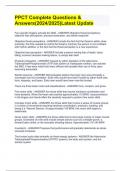PPCT Complete Questions &
Answers(2024/2025)Latest Update
Four specific triggers activate the SNS - ANSWER Objective threat perceptions,
objective fear perceptions, physical exhaustion, and startle response
Objective threat perceptions - ANSWER Include the fact that the threat is within close
proximity, the time needed to control the threat is minimal, the person is not confident
with his/her abilities, or the fact that the threat perception is a new experience
Objective fear perception - ANSWER Include a person having fear of death, injury,
killing, incorrect decision-making failure, or simply fear itself
Physical exhaustion - ANSWER Caused by either depletion of the Adenosine
Triphosphate/Phosphocreatin (ATP) fuel system or inadequate nutrition, can activate
the SNS. It has been noted that many officers will escalate their use of force upon
becoming exhausted
Startle response - ANSWER Athropologists believe that early man was principally a
scavenger and not a predator. Early man would have been hunted by saber-tooth cats,
lions, leopards, and bears. Early man would have been man-the hunted
There are three basic motor skill classifications - ANSWER Fine, complex, and gross
Fine motor skills - ANSWER Are those skills that require hand/eye coordination and
hand dexterity. When the heart rate reaches approximately 115 BPM, vasoconstriction
in the fingers and hands effect the dexterity required to perform fine motor skills.
Complex motor skills - ANSWER Are those skills that involve a series of muscle groups
in a series of movements requiring hand/eye coordination, precision, tracking, and
timing (i.e. Weaver Stance). At approximately 145 BPM, this motor skill begins to
deteriorate.
Gross motor skills - ANSWER Are those skills that involve large muscle or major muscle
groups. Examples of a this skill include simple actions such as a straight punch, a
forward baton strike, or the isosceles shooting stance. Approximately 115-145 BPM
Inverted-U - ANSWER Proposes that performance will gradually deteriorate as stress
(arousal) increases
The human body relies primarily on three energy systems - ANSWER the Adenosine
Triphosphate/Phosphocreatine (ATP/PC system), the lactic acid system, and the
aerobic system
, ATP/PC System - ANSWER Consists of small energy bundles that are stored in the
muscles. When this system is engaged, the officer is able to perform at 100% of his/her
maximum output. The system burns out after 10-15 seconds, at that time the officer can
expect to have a 45% decrease in maximum output
Lactic Acid System - ANSWER This fuel system does not burn as hot as the ATP
system, but will provide about 45 seconds of intermediate strength and endurance.
Once this system is engaged, the officer's strength level will reduce to 55% of maximum
output at 30 seconds, and then drop to 35% of maximum output at 60 seconds
Aerobic System - ANSWER This system is fueled by a combination of oxygen,
carbohydrates, and free fatty acid. This system is very economical and can burn for long
periods, depending on the officer's cardio/respiratory conditioning. The officer's
maximum output will be reduced to approximately 31%
Components of acceptability - ANSWER Tactical, legal and medical
Use of force continuum are structured around two different theories - ANSWER Total
Control Theory and One-Plus-One Theory
Total Control Theory - ANSWER IS normally associated with a training system centered
upon the use of intermediate weapon. This theory allows a specific type of tool to be
used to control all levels of resistance.
One-Plus-One Theory - ANSWER Is the more conservative use of force theory, based
upon the concept of responding to resistance with proportional use of force. This theory
advocates that officers can use one level of force higher than the level the resistance
used by the subject
Levels of resistance - ANSWER Psychological intimidation, verbal noncompliance,
passive resistance, defensive resistance, active aggression, deadly force
Psychological Intimidation - ANSWER Nonverbal cues indicating subject's attitude,
appearance, and physical readiness. The subject may comply with verbal attempts at
control, but display visual nonverbal cues that indicated potential physical resistance
Verbal Noncompliance - ANSWER Is any verbal response indicating subject
unwillingness to obey commands of detainment, arrest, or to stop unlawful or dangerous
behavior
Passive Resistance - ANSWER Is any type of resistance where the subject does not
attempt to defeat the officer's attempt to touch or control him/her, but he.she still will not
voluntarily comply with verbal and physical attempts of control





